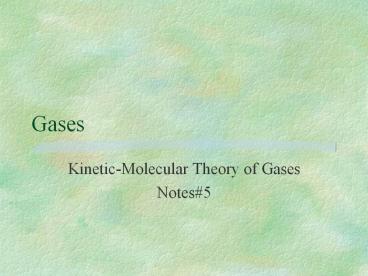Gases - PowerPoint PPT Presentation
Title: Gases
1
Gases
- Kinetic-Molecular Theory of Gases
- Notes5
2
- All particles are in constant motion.
- As temperature increases kinetic energy ?
increases
increases
- As gas particles move apart the volume ?
3
Point Masses
- Gas particles are treated as a point with no
volume and no mutual attraction - -this is because theyre so small compared to
the distances between them.
4
Ideal Gases
- A theoretical gas with no volume and no
attraction. - A series of theories will be studied about ideal
gases - -standard pressure of 101.32 kPa
- -standard temperature of 0C or 273K
- -standard conditions are abbreviated
- STP
5
Therefore
- Kinetic theory explains properties of gases based
on a molecular view. - The assumptions are
- The molecules are in continuous, random motion.
- A molecule has negligible volume.
- The forces between molecules are negligible.
- The average kinetic energy depends on the
temperature.
6
Four Gas Law Variables Are
- V volume
- P pressure
- T temperature
- n number of particles
- (Case is important)
7
Behavior of Gases
- Compression
- Expansion
- Diffusion movement of material from high to low
concentration - - lighter particles diffuse faster than heavier
particles - Effusion- gas escapes through a tiny opening
8
Gas Pressure
- Pressure force/area
- Snowshoes in the snow force is spread out over
a larger area - Gas particles exert pressure as they collide with
the walls of their container - More particles in a given space, greater pressure
- Barometer is tool used to measure atmospheric
pressure mercury rises or falls
9
Units of pressure
- SI unit is Pascal (Pa)
- 1Pa 1 N/m2 derived from force
- 1atm 760mm Hg 760 torr 101.3 kPa 14.7 psi
- 1torr 1 mm Hg
10
Daltons Law of Partial Pressure
- Total pressure of a mixture of gases is equal to
the sum of all the pressures of the individual
gases - Pg. 392 practice problems
11
Boyles Law
- Relates volume and pressure
- -gas exerts pressure on its containers walls
- -pressure depends on
- number of molecules
- average kinetic energy of the molecules
.
- Pressure P
.
12
Boyles Law
- Relates volume and pressure
- -gas exerts pressure on its containers walls
- -pressure depends on
- number of molecules
- average kinetic energy of the molecules
- Plunger applies pressure (now 2P).
- -As pressure doubles, volume
becomes ½. - -(note the same number of particles now
occupying ½ the space)
.
.
.
.
.
.
.
13
Boyles Law
- Boyles Law PVk
- Ppressure
- V volume
- kconstant
- Experiments happen at room temperature(about
25ºC.) We need to convert the results to STP.
14
Boyles Law
- Since and
- then (substituting for k)
15
Boyles Law
- Since and
- then (substituting for k)
- or
16
Boyles Law
- Since and
- then (substituting for k)
- or
- Units
- pressure - kPa
- volume - cm3
17
Problem a gas is collected in a 242 cm3
container at 87.6 kPa. What is its volume at
STP?
- V1 P1 V2 P2
101.325 kPa
- Think pressure goes from 87.6 kPa to 101.325
kPa so Volume should be________ than 242 cm3 - Math
18
- so
- Note 209 lt 242cm3
- Now do CMC 358 1, 2, 3(a,c,e) and 4(a,c,e).































